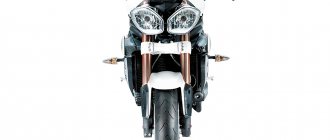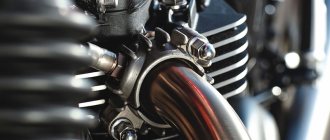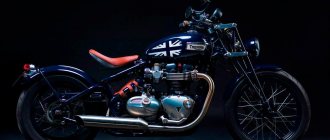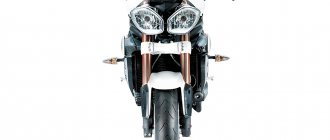Comparison test
Both are far from ideal for fast highway driving. That is, technically this is quite possible, but both of them lack even a hint of a windshield or fairing. The BMW R nineT has a lower handlebar, so the rider sits in a slightly more aggressive position, which helps it resist the wind better - and that's where the difference in aerodynamics ends. In a thick jacket and a good helmet in pleasant weather, you can safely go out on the highway without a windshield - the only pity is that there is no cruise control on both.
BMW R nineT and Triumph Speed Twin
The footpegs on the BMW R nineT are positioned ideally for a height of 170 centimeters. The cylinders, despite the air-oil cooling scheme, practically do not bake, the seat is a pleasant width, the knees comfortably cover the large 18-liter tank, and the suspension handles most bumps quite well. A significant part of the significant price of the BMW is the 46 fork with a full range of adjustments and a link rear suspension with a rebound adjuster and a convenient preload knob. Some of the earlier BMW R nineTs (remember, I said there are many different ones) are not very good on the road in terms of suspensions. And this one is completely okay. Over the past years, all glitches have been shaken out of its engine, which appeared back in 1993. 5000 rpm at 130 km/h is a bit short for such an engine, but it pulls well in any gear and at any speed. At some speeds and revs, noticeable vibrations make their way through the steering wheel, but they never reach or dry out your hands, and the engine sounds like a bumblebee (which is not surprising, given BMW's aviation past).
The BMW R nineT has a slightly lower seat than the Triumph Speed Twin, has a 5cm longer wheelbase, is equipped with a steering damper and rides on rails at high speeds - on very smooth and straight rails.
The Triumph Speed Twin is not quite as good as the BMW in terms of highway comfort, mainly due to its more upright stance, but the old-school 41 fork with two shock absorbers at the rear can’t compare with the BMW R nineT’s suspension. This, plus the lack of a steering damper, makes the Triumph's gait a little more wobble over small bumps.
BMW R nineT and Triumph Speed Twin seat
The narrow tank with a volume of 14 liters, which looked ideal at the Thruxton cafe, is too small here, including visually and between the knees. The footpegs are further forward and down compared to the Thruxton, but they still go back a little more than on the BMW, and the knees are noticeably bent more, especially if you sit right next to the tank. Luckily, the seat is flat and you can sit back and lean towards the steering wheel, making the riding position comfortable enough for high speeds. The narrow tank easily allows hot air from the engine to pass through, which is good on cool days, but not very pleasant on hot days. Of course, this heat cannot be compared with the early Indian Chieftain, which simply fried the rider in the most inappropriate places, but it’s still hot. And 14 liters with a consumption of almost 6 per hundred is not cool.
The Triumph series transmission transmits quite noticeable vibrations to the handles at 130 km/h (4500 rpm), but unscrew it a little and they go away. The cubic capacity makes itself felt: both motorcycles easily make their “ton” - i.e. 160 km/h, and then they accelerate only a little slower. I still don’t understand whether there is a speed cutoff on them, but in terms of revolutions it is at 7 thousand. However, there is no particular point in turning it up there; the engine outputs a maximum of 6600.
BMW R nineT and Triumph Speed Twin engines
Back to the future: test drive the BMW R nineT Racer
The plastic world has won - a modern motorcycle is more like Tetris, requiring less and less skills, replacing skills with a suitable mode, which not everyone likes. My generation, like the older generation, who remembers motorcycles capable of accelerating far beyond two hundred one-on-one with a pilot, does not always warmly accept new items. And even if he accepts it, he still begins to yearn for the good old days. It was for us that BMW released the R nineT, as an ironclad exception to the plastic rules.
I wonder if fashion is dragging motorcycle manufacturers along with it, or is it manufacturers dragging fashion along with it? Since its introduction, the R nineT has become a bestseller and fits perfectly into the trend of hipster cars, while remaining absolutely honest and thoroughbred, unlike many other motorcycles created for those who like to smear smoothies on their beards, and not ride. The success of the niche device, created contrary to all the laws of evolution, turned out to be such that this year, on its basis, a nostalgic “sport” with a fairing, retro-enduro and several other modifications appeared, differing in design elements.
The complete line of “air” BMWs: Urban G/S, Racer, Scrambler, Pure and the original R nIneT. Photo – BMW Motorrad
Each of them can go crazy, and one of them will be discussed below, but first, let's remember the story. 20 years ago, the Germans already had a desire to create an iron motorcycle, which resulted in the appearance of a cruiser built on an opposed platform and named R1200C. A motorcycle that had a lot of chrome and polished aluminum, but, on the contrary, a minimum of plastic, and all this on the “correct” spoked wheels!
In those days it was difficult to call him beautiful, but by today's standards, the appearance of the German neoclassicist is harmonious. And thanks to the telelever lever and the “frameless” design used by the Bavarians at that time, the motorcycle turned out to be very original and, unlike many others, did not copy the Harley style, but took it as a starting point, completely rethinking it in further development.
The R1200C motorcycle is BMW's first attempt in modern history to create an “iron motorcycle”
And, apparently, the special motorcycle turned out to be too special - the device did not gain much popularity either in the basic version or in the almost annual special versions that rained down: Avantgarde, Independent, Montauk, CL and CLC, even the Troika equipment, equipped with a side trailer and In 2004, the device was discontinued. Then, as now, people expected innovations and new records from BMW, not old-time sofas. This is where the topic of experimentation in the conservative classic segment ended for the Germans; the R1150R remained in production, which in 2006 was replaced by the R1200R - a large roadster with a round headlight.
The device, which remained in production for almost 10 years, was radically updated by 2015. In fact, the “R” index was assigned to a completely new motorcycle, built around the next generation of liquid-cooled boxer, which became the ideological successor to the “old” R1200R and featured a much more modern design. But fans of the latest old-school motorcycle in the BMW lineup were offered something completely different.
Modern BMW R1200R with a new engine and plenty of electronics
The motorcycle, which appeared in 2015, was a real revelation. Just imagine - the café racer design, boxer air, spoked wheels, the finishing is the realm of polished aluminum, the frame pipes are clearly visible, but most importantly - the place of the Telelever, beloved by the Bavarians, has been taken by a traditional inverted “telescope”! Apparently, remembering past mistakes, the Bavarians decided not to cross a hedgehog with a snake and built a real classic, without any “neo” prefixes, which is worth the nameplate with the frame number, riveted to the steering column just like on my grandfather’s “Ural”, God forgive me.
But this is only one component of success, the second is the possibility of customization, which the Germans built into the motorcycle and actively promoted in every possible way. Even the uncontested black color in which the motorcycle was initially sold emphasized that it was not so much a motorcycle as a custom blank, a blank canvas on which you can create whatever you want. And off we go: in 2016, the “Scrambler” saw the light of day, and this year, 2017, a whole galaxy of “NineT” models with different wheels and tails were rolled out onto the market.
A handsome R nineT Racer surrounded by gridgirls in the paddock of the Moscow Raceway. Photo – Dmitry Osipov
We got the R nineT Racer for testing. This, in my opinion, is the brightest and coolest representative of the entire family: a semi-fairing in the style of sport bikes of the 70s, a “cafe” tail with a plastic “chastity hump”, clip-ons instead of a steering wheel and a pair of tidy glasses in the fashion of past years - an icon! And the white color with branded graphics, again, designed in a nostalgic style, emphasizes the oldness. Well, what else is needed for complete happiness?!
The dashboard is made in classic double glasses, fonts, colors - everything is on point
In fact, there is one more thing - a telescopic fork. And not inverted, but traditional, with “glasses” at the bottom. The height of archaism, knocking tears out of true motorcycle fans. By the way, at the end of the 30s, BMW became one of the first motorcycle brands, and a little later, by the end of the 80s, it was the first to abandon it en masse, introducing “teleever” and “parallelogram”.
Instead of the usual telelever for BMW, the R nineT uses a classic telescopic fork
The R nineT Racer fork has no adjustments and, importantly, is noticeably inferior to its inverted counterparts in terms of torsional rigidity. Together with the rest of the motorcycle chassis elements, which are not loose, but not too rigid, the new-old sportbike barely lives under you, especially at the entrance to a turn, when you drop a couple of gears down at once. And this is the main difference between the new product and the “just” R nineT, which behaved the same way, with the only difference being that at the entrance to the turn its chassis played around a more elastic fork.
This is not a drawback, no, just another feature, precisely calibrated on German scales, just like the clip-ons instead of the steering wheel and the driver’s footpegs raised up and noticeably pushed back, adding a sporty stance. By the way, the footpegs are also raised properly - I’m not used to the fetal position behind the wheel, but on the contrary, I’m used to touching the gearbox pedal in turns. Why not raise it? Yes, because if you keep the penny paw intact, it won’t take long to reach the asphalt with the cylinder, and this is a risk of dropping the motorcycle or damaging the valve cover, completely different money in any case.
The heart of the new product is a time-tested two-cylinder boxer with air-oil cooling
But even with the pots sticking out to the sides, the device has plenty of sporting potential, in the hands of a professional, the R nineT easily outruns dummies on “liters”, and the maximum speed, which for our test subject is slightly over 200, is enough not to get bored during kilometer straight Moscow Race Way. And at the end of it, the brakes give no cause for concern, the potential of which is sufficient for effective braking from any speed, and for those who are especially timid, traditionally for BMW, the device is equipped with anti-lock.
The footpegs hit the asphalt quite early in the turn, however, this is the best indicator of the cylinder approaching the asphalt
However, the main feature of the motorcycle is not even the design, but the engine and transmission. This is the old 1200 cc air-cooled boxer, which was once found across the entire BMW model range, but is now left in production only for the nineT family. The engine, without exaggeration, is legendary, reliable and torquey. Of course, he loses to the new generation, but, it seems to me, he has much more soul. And what a sound! The sound of a helicopter, no less, and also seasoned with light vibrations with a gyroscopic moment, slightly pushing the motorcycle to the right as it picks up speed.
The new device is good precisely because of its imperfections, leave the technology to the schoolchildren! Photo – Dmitry Osipov
As for the transmission, the gearshift lever is distinguished by the traditional BMW long stroke and sensitivity to mis-shifts: if you missed a gear, didn’t bring the paw up - hello false “neutral”, for example, between “fourth” and “fifth”, it will be difficult to change from a Japanese motorcycle. To me, the owner of an ancient BMW, the gearbox algorithm seems painfully familiar and even familiar, and there are no problems with switching, house slippers, no matter what.
The R NineT Racer has a rare combination of interior and exterior aesthetics, traditional but not old
The same applies to the clutch - after Japanese “wet” multi-disc mechanisms, the left lever may seem a little tight, and you will have to get used to its operation, but it is still far from the on/off algorithm. As for the cardan hidden inside the cantilever pendulum, it will only be unusual to feel a slight play at start-up; there will be no problems while driving, and the much longer service life and service intervals, relative to the chain drive, will generally be a gift for those who like to turn the nuts only in in the context of installing new baubles.
A sportbike with spokes? A tribute to old times, witnesses of which have long been occupied by queues at the clinic. Photo – D. Osipov
It’s for them that “Nine Ti” was created, and the “Racer” prefix... Of course, it won’t make you a sport biker, but a fast guy who can show off at the lookout on a Friday evening, confidently beat the sword in a crowd of bearded foresters in the city center, and in the morning Saturday driving the same motorcycle to show excellent times at track days – perhaps. At the same time, NineT is by no means a compromise solution that works lousy in both cases - the device is really good in both guises. However, in order to understand to what extent, first you will have to drive everything else for ten years, so that teenagers in sneakers flying forward from traffic lights under the roar of a burnt-out six-hundred-hour forward flow would cause nothing but a smile. School kids don't understand!
We thank BMW Motorrad for providing the motorcycle and assistance in organizing the filming.
Accreditation and organization of test drives – Denis Sokolov | | +7 (999) 851-49-71
On the run
Let's be honest: overliters are not needed to drive slowly. Both handle this quite well, and it’s interesting how differently: the BMW boxer is an excellent engine, powerful and torquey, but the peak of its capabilities occurs at 3500 rpm. It has an almost automotive character, and it’s not even surprising that it is stubbornly equipped with a single-plate clutch. Due to the longer wheelbase and steering damper, the BMW turns a little less responsively, but it doesn’t wobble at every bump. This is felt on good asphalt, but is especially noticeable on uneven paths.
But the ability to accelerate alone is not enough; you also need to turn and brake. The 320's with radial calipers on the BMW R nineT are much more interesting than the Triumph Speed Twin braking system . Its 305 wheels, however, also stop the motorcycle quite adequately, but, as always, the devil is in the details.
brake system of BMW R nineT and Triumph Speed Twin
But the Triumph Speed Twin has an advantage when driving on small, winding roads. It's shorter, has a shorter fork offset, a higher center of gravity and a narrower rear wheel, so it's much quicker and more willing to turn. Yes, its suspensions do not smooth out bumps as well as the BMW, but they do a good job of keeping the motorcycle on line both in corners and when driving fast in a straight line. The six-speed gearbox and chain drive allow you to shift less often and smoother than the driveshaft on a BMW.
For those who find the Triumph's Sport riding mode too bouncy, there's a Road mode where the response is just as immediate and the traction is excellent right from the bottom. The engine runs smoothly and smoothly, and the seating position is optimal for leisurely rides along the highway.
The steering wheel of the BMW R nineT, in my opinion, is a little wide for a collected position, but despite the more nimble geometry of the Triumph Speed Twin and lower weight, the BMW steers quite on par with it , except that it requires a little more effort for this. On higher-speed sections, BMW could, if desired, overtake Triumph (however, as I already said, in terms of acceleration, their capabilities clearly exceed our needs)
Specifications
| Engine | |
| Construction type | Four-stroke two-cylinder boxer engine with air-oil cooling; two camshafts and four radial valves per cylinder; central balance shaft |
| Bore/Stroke | 101 mm x 73 mm |
| Working volume | 1170 cm3 |
| Rated power | 81 kW (110 hp) at 7500 rpm |
| Max. torque | 119 Nm at 6000 rpm |
| Compression ratio | 12,0 : 1 |
| Type of mixture formation / engine control system | Electronic fuel injection |
| Exhaust gas cleaning | Three-way closed-loop catalytic converter, EU-3 compliant |
| Power reserve/consumption | |
| Maximum speed | over 200 km/h |
| Consumption per 100 kilometers at a constant pace of 90 km/h | 4.5 l |
| Consumption per 100 kilometers at a constant pace of 120 km/h | 5.8 l |
| Fuel type | RON 95–98 unleaded gasoline (power output based on 98 octane) |
| Electrics | |
| Generator | three-phase generator, 600 W |
| battery | maintenance-free, 12 V/14 Ah |
| Traction transmission | |
| Clutch | Dry single disc clutch with hydraulic drive |
| Transmission | Six-speed gearbox with constant mesh helical gears |
| Drive unit | Cardan transmission |
| Chassis/brakes | |
| Frame | Frame of four sections: one front and three rear; supporting unit of the engine and gearbox; Removable rear seat frame for transformation into a single-seat version |
| Front wheel suspension | 46mm inverted telescopic fork |
| Rear wheel suspension | Cast aluminum single-sided swing arm with BMW Motorrad Paralever suspension, central shock absorber strut, hydraulic (infinitely variable) spring preload adjustment via corresponding rotary knob, rebound adjustment |
| Suspension travel front/rear | 120 mm / 135 mm |
| Base | 1476 mm |
| Front fork offset | 102.5 mm |
| Fork angle | 64,5 ° |
| Wheels | Spoke wheels |
| Front Disc Size | 3.50 x 17″ |
| Rear Disc Size | 5.50 x 17″ |
| Front tire | 120/70 ZR 17 |
| Rear tire | 180/55 ZR 17 |
| Front brake | Dual disc front brake, 320 mm floating discs, four-piston radial calipers |
| Rear brake | Single disc, diameter 265 mm, two-piston floating caliper |
| ABS | BMW Motorrad ABS |
| Dimensions/weight | |
| Length | 2220 mm |
| Width (by mirrors) | 890 mm |
| Height (without mirrors) | 1265 mm |
| Seat height when unladen | 785 mm |
| Length along the inner seam of the trousers when empty | 1760 mm |
| Curb weight with full tank 1) | 222 kg |
| Maximum permissible weight | 430 kg |
| Additional load (standard) | 208 kg |
| Useful fuel tank volume | 18 l |
| From this reserve volume | OK. 3 l |
Appearance
We love thoughtful little details in design, and BMW is on point here. Colored fork adjusters, knobs, badges, aluminum brackets, painting again (we were told that people pay almost 100 thousand for a scheme like the one on our example). We expected a little more attention to detail from the Speed Twin, but Triumph decided to go the honorable route of keeping it simple out of respect for the prototype. Well, if it still seems rustic, there will probably be some more expensive version.
Photos, by the way, do not reflect the essence: both motorcycles look great in person. The 2021 BMW R nineT stands out for its well-made details, while the 2021 Triumph Speed Twin stands out for its modern interpretation of a classic design, including that red tank.
Both motorcycles are bright representatives of their legendary brands in the classic confrontation between Britain and Germany. Both are modern implementations of classic designs, and it’s very good that they are modern: injector, traction control and ABS are simply the demands of the times, especially on 1200cc. Of course, it would be funny to bring in a Royal Enfield for comparison, a carb one, of course, but everyone understands that these are different leagues, right?
BMW R nineT 2020 and Triumph Speed Twin 2020











